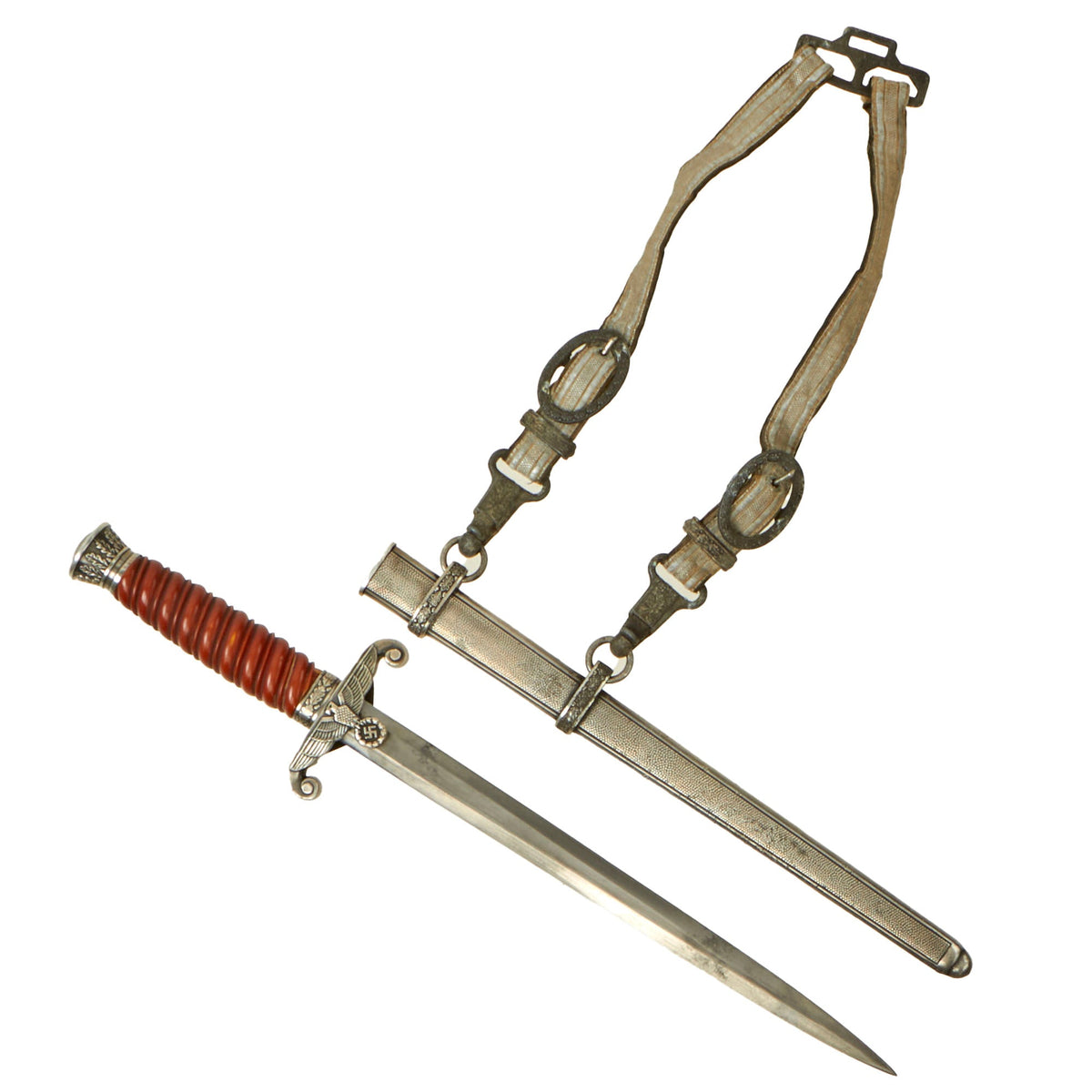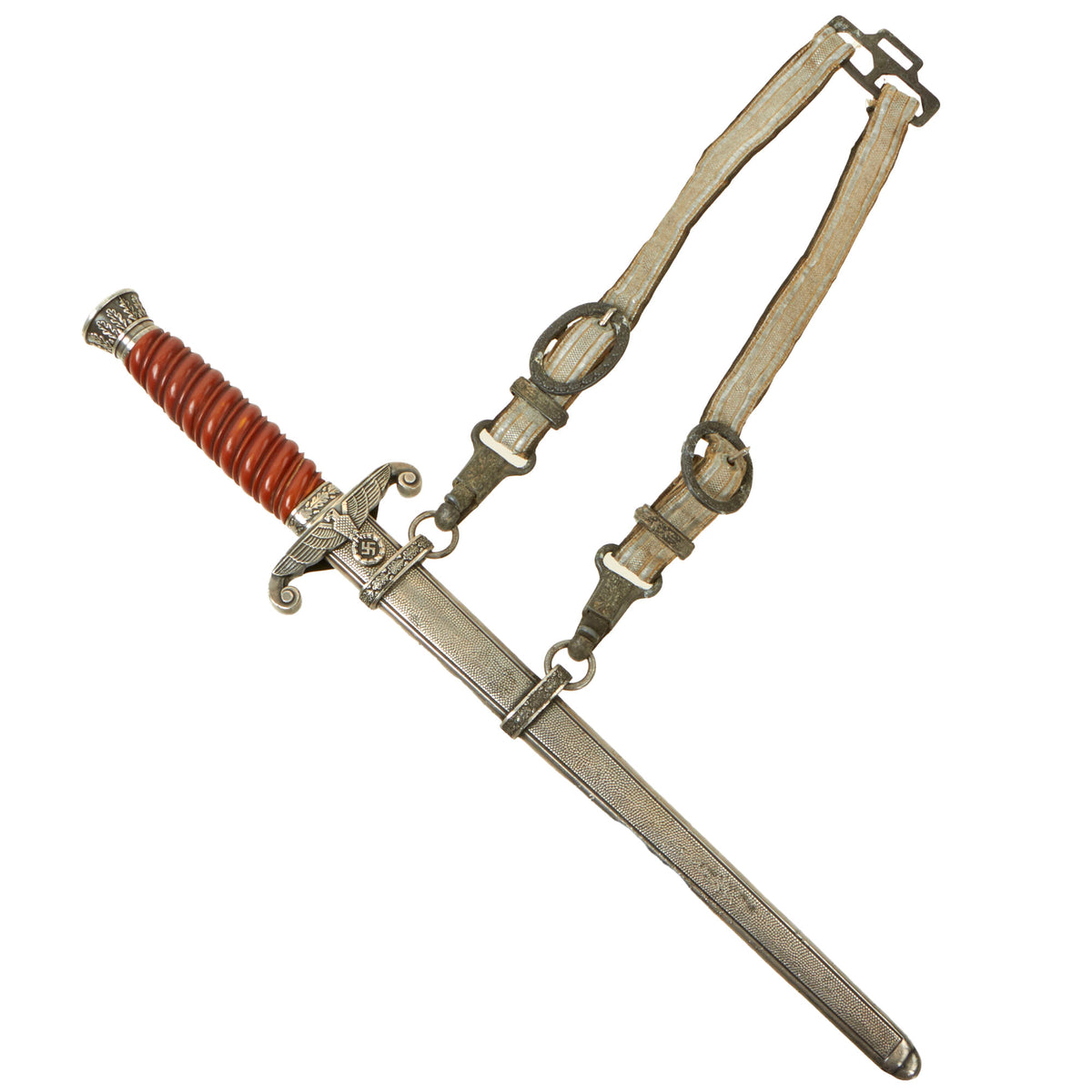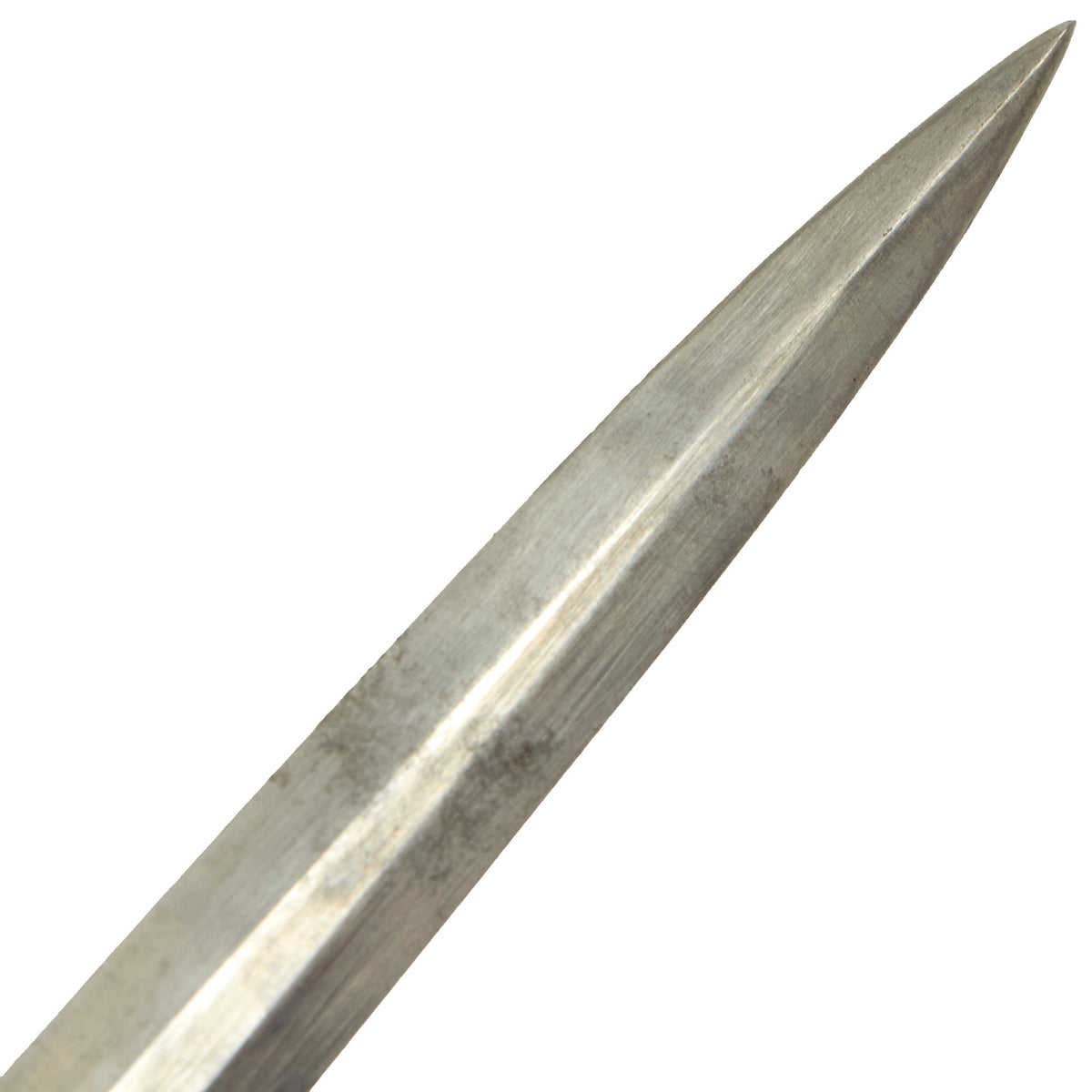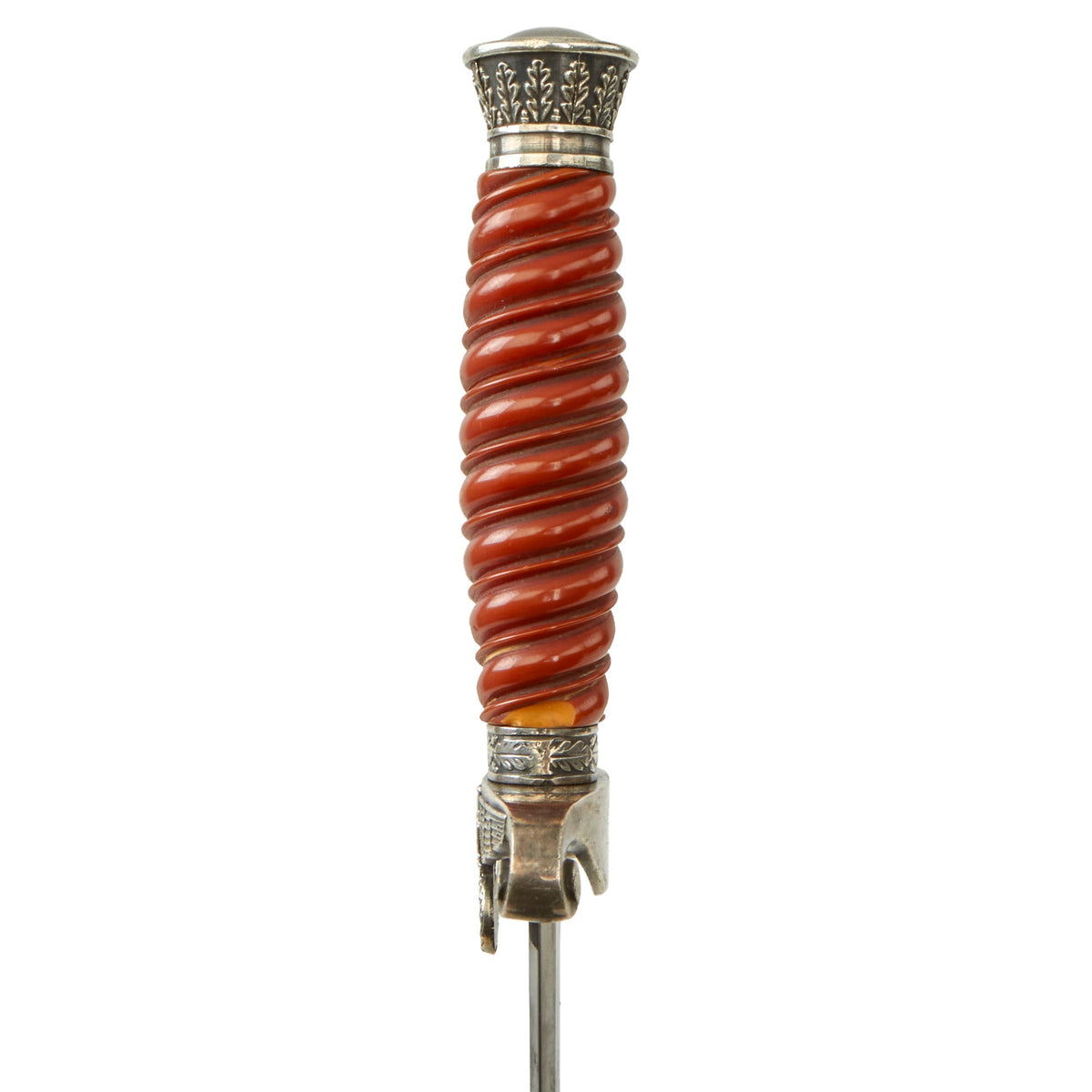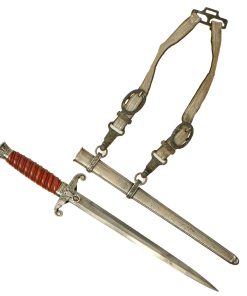Original German WWII Army Heer Officer Dagger with Scabbard & Hanger – Unmarked Blade Original Items
$ 895,00 $ 223,75
Original Item: Only One Available. This is a very good condition Army Officer’s Dagger, complete with the original scabbard. The blade on this example is unmarked, but this is not unusual, as many smaller outfitters would purchase finished blades and blade blanks from major factories, and then fit the blades themselves. This dagger looks to have been fit with cast aluminum, which was then plated and antiqued to give it a great look. The pommel of this dagger is in very good condition, showing wear and light scratching around the edge. The original plating is still well retained on the sides and bottom, with a good deal of the antiquing still present. The standing oak leaves and acorns around the sides are crisply detailed and have good backgrounds.
The aluminum alloy cross guard is in similar condition, with much of the original plating present except on the corner wear areas, with some of the antiquing still present. The details throughout the characteristic eagle are very good throughout the head, breast and wing feathering, talons and wreathed mobile swas (hook cross). The grip ferrule is plated steel, which still retains most of the original finish and antiquing.
The celluloid covered wood grip on this dagger has faded quite a bit to a dark “pumpkin” orange color, showing some wear in areas. One side is a bit darker than the other, so that was probably exposed to light more. The grip is in very good condition, with the antiquing in the grooves still present, though there is a chunk missing on the side, which shows how much lighter in color the grip is under the surface. The hilt is still tight on the tang, and the original blade buffer is still present in the recesses of the guard.
The very good condition blade is mostly bright throughout, showing the original factory final grind cross grain throughout the blade, retained to a varying degree. This texture is iconic, and is the definitive identifying characteristic for a real WWII German Blade. There is a bit of light staining in areas, as well as wear and swirlies from cleaning. There is a bit of denting on the edge, and the last inch or so close to the tip does look to have been sharpened, possibly due to tip damage.
The scabbard is a fine example, and is steel with what looks to be silver plating, which is still very well retained. It does show a bit of scattered light bubbling in the plating, but no major plating loss. This straight scabbard has very crisp, finely grained panels. The zinc alloy carrying bands have an excellent pattern of overlapping oak leaves and acorns, which are nicely enhanced, but also show some wear and oxidation where the plating has flaked away. The throat is the thinner style, and has a single flush mount securing screw on the rear side.
Attached to the scabbard is a good service used condition belt hanger, with functional pebbled spring clips with a great patina. The buckles and keepers are engraved with the same oak and acorn motif seen throughout the dagger. The clips are the more desirable “sliding” type, both marked D.R.G.M. on the back, indicating it is a trademarked design. The original plating on the fittings is almost completely missing, with just a few traces present and oxidized. The straps are in good condition, showing the bullion on the front well, however there is fairly extensive wear on the reverse, so this early dagger definitely saw long service.
A very nice example of an Army Officer Dagger, complete with an original scabbard and hanger! Ready to display!
Specifications:
Blade Length: 10″
Blade Style: Spear Point Dagger
Overall length: 14 5/8“
Crossguard: 2 3/4”
Scabbard Length: 10 7/8″
The German Army (Heer) first carried a dagger beginning in 1935. The weapon was worn in lieu of occasions not demanding the wearing of a more formal sword. The dagger design was quite attractive featuring silvered heavy fittings with white or colored grip. The crossguard depicted a Wehrmacht open-winged eagle clutching a wreathed swas.
The pommel depicted oak leafing around the outer circumference. The scabbard had panels of pebble designs. Later produced examples were plated with nickel, and late war-made pieces were unplated, finished in a gray color metal. These daggers are often encountered with an aluminum portepee.
Fast Shipping with Professional Packaging
Thanks to our longstanding association with UPS FedEx DHL, and other major international carriers, we are able to provide a range of shipping options. Our warehouse staff is expertly trained and will wrap your products according to our exact and precise specifications. Prior to shipping, your goods will be thoroughly examined and securely secured. We ship to thousands clients each day across multiple countries. This shows how we're dedicated to be the largest retailer on the internet. Warehouses and distribution centres can be located throughout Europe as well as the USA.
Note: Orders with more than one item will be assigned a processing date depending on the item.
Before shipping before shipping, we'll conduct a thorough inspection of the items you have ordered. Today, the majority of orders will be delivered within 48 hours. The delivery time will be between 3-7 days.
Returns
The stock is dynamic and we cannot completely manage it because multiple stakeholders are involved, including our factory and warehouse. So the actual stock may alter at any time. It's possible that you may not receive your order once the order has been made.
Our policy is valid for a period of 30 days. If you don't receive the product within 30 days, we are not able to issue a refund or an exchange.
You can only return an item if it is unused and in the same state as the day you received it. You must have the item in its original packaging.
Related products
Uncategorized
Uncategorized
Armoured Fighting Vehicles of the World: AFVs of World War One (Hardcover Book) New Made Items
Uncategorized
Australian WWII Owen MK1 Machine Carbine SMG Custom Fabricated Replica with Sling Original Items
Uncategorized
Uncategorized
Uncategorized
Band of Brothers ORIGINAL GERMAN WWII Le. F.H. 18 10.5cm ARTILLERY PIECE Original Items
Uncategorized
Armored Burgonet Helmet & Polearm from Scottish Castle Leith Hall Circa 1700 Original Items
Uncategorized
Uncategorized
Uncategorized
Uncategorized
Uncategorized
Uncategorized
Uncategorized
Uncategorized
